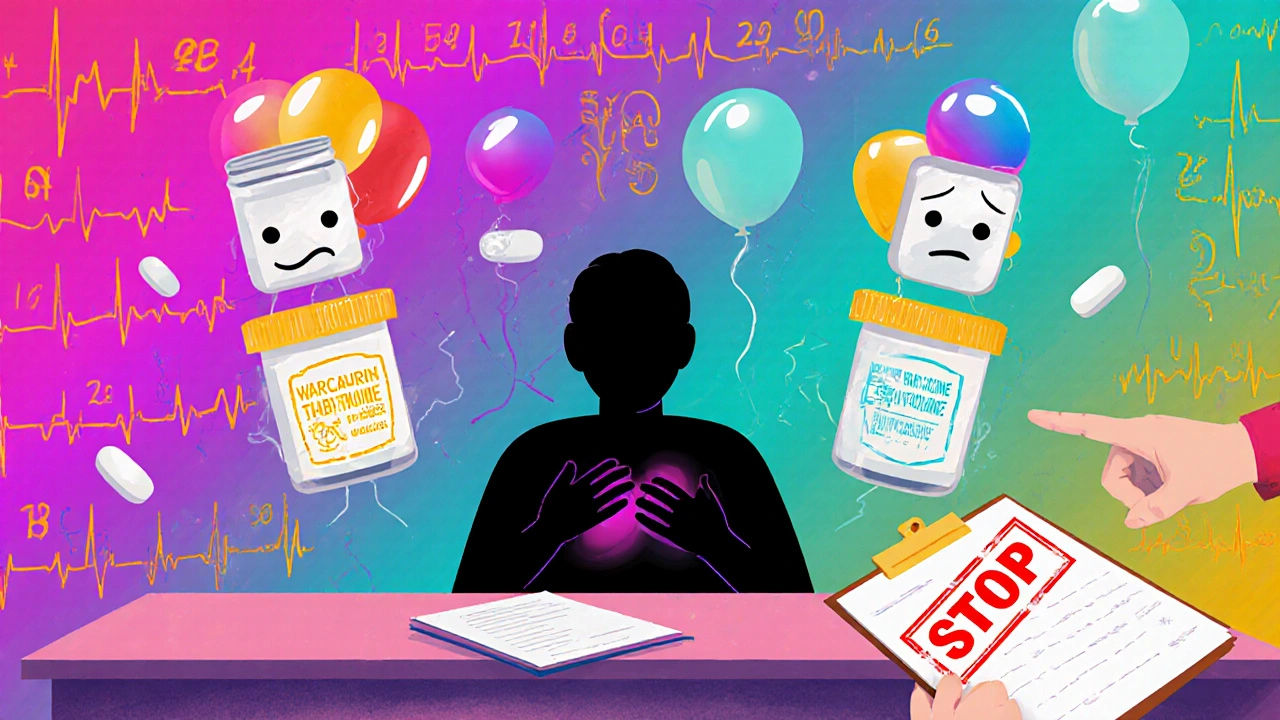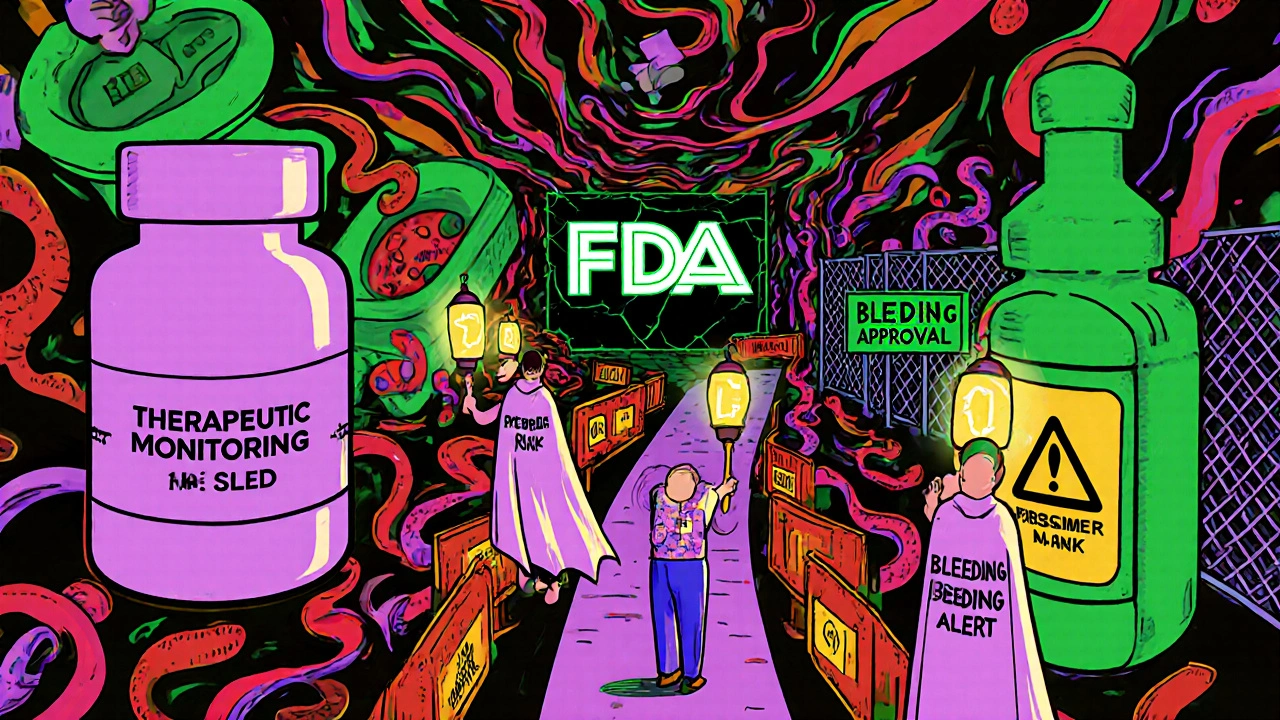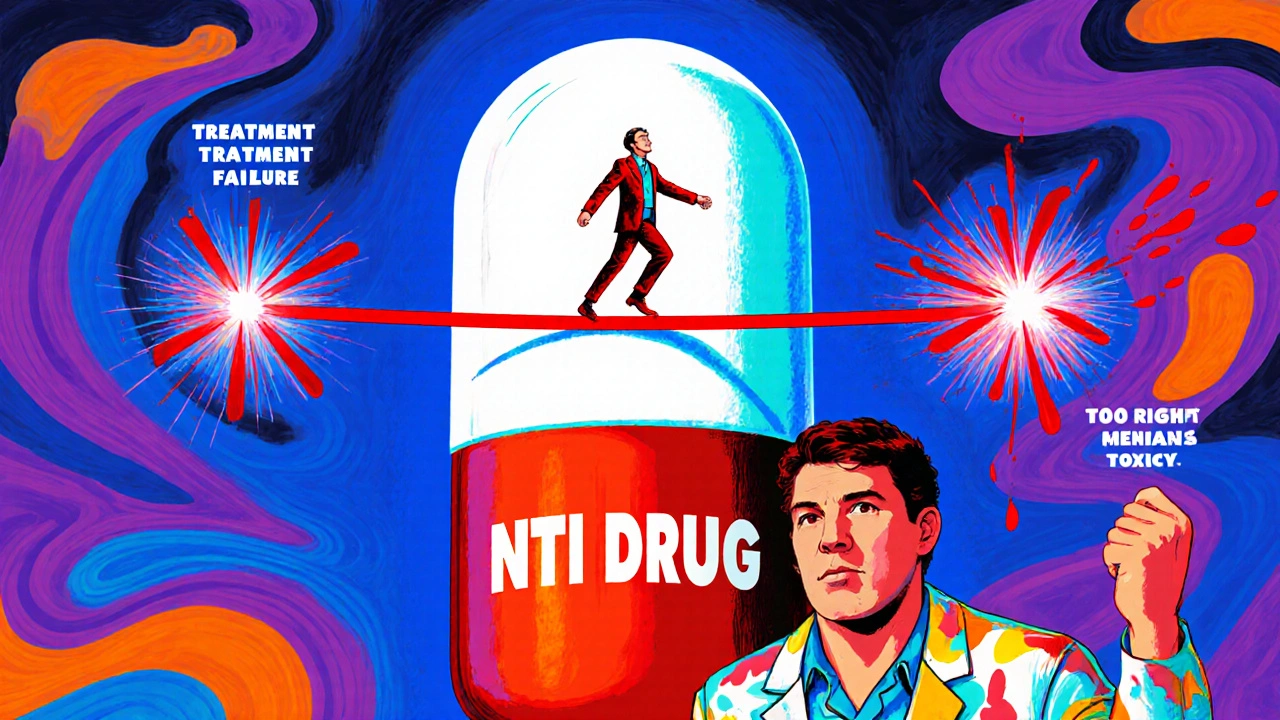When a pharmacist hands you a pill bottle labeled as a generic version of your brand-name medication, most people assume it’s exactly the same. But for drugs with a narrow therapeutic index (NTI), that assumption can be dangerous. These aren’t ordinary pills. A tiny shift in how your body absorbs the drug-just 10%-can mean the difference between effective treatment and life-threatening toxicity or treatment failure. And pharmacists are sounding the alarm.
What Makes a Drug an NTI Drug?
NTI drugs have a razor-thin margin between a dose that works and one that harms. Think of it like walking a tightrope: too little, and the condition returns. Too much, and you risk organ damage, bleeding, seizures, or worse. Common examples include warfarin (a blood thinner), levothyroxine (for thyroid function), phenytoin (for seizures), and carbamazepine (for epilepsy and nerve pain).
The FDA doesn’t publish an official list, but it flags these drugs in the Orange Book with special codes. For most generics, bioequivalence is measured at 80-125% of the brand’s absorption rate. For NTI drugs, that range tightens to 90-111%. Even then, pharmacists say that’s still too wide. A 2024 study from the University of Minnesota found 15 NTI drugs where even small bioavailability differences led to real clinical harm-like INR spikes in patients on warfarin or seizures triggered by phenytoin level drops.
Why Pharmacists Are Worried
It’s not about distrust in generics. It’s about consistency. In community pharmacies, automatic substitution is standard. But with NTI drugs, switching between different generic manufacturers-even ones approved by the FDA-can cause blood levels to swing unpredictably. One pharmacist in Sydney told me about a patient on levothyroxine who went from feeling fine to exhausted, depressed, and gaining weight after a routine switch to a new generic. Her TSH levels jumped from 2.1 to 8.7 in three weeks. She had to go back to the brand.
According to the American Society of Health-System Pharmacists (ASHP), 68% of pharmacists surveyed in 2024 reported serious concerns about NTI generic substitution. In hospitals, 78% said they needed extra training beyond pharmacy school to manage these drugs safely. Why? Because therapeutic drug monitoring isn’t just a formality-it’s essential. But not every patient gets it. Not every doctor orders it. And not every pharmacy has the tools to track it.
The Real Cost of Substitution
Yes, generics save money. Warfarin generics cost 80-85% less than the brand. That’s huge for patients on fixed incomes. But the hidden cost? Hospitalizations. Between 2020 and 2024, the FDA’s adverse event database recorded 1,247 incidents tied to NTI generic switches-nearly three times the number for non-NTI generics. Many involved bleeding, arrhythmias, or seizure recurrence. One Reddit thread from a hospital pharmacist in Ohio described three patients admitted for INR-related bleeds after a pharmacy switched their warfarin brand without warning.
And it’s not just about individual cases. The FDA reported that 23% of NTI drug shortages in 2024 were worsened by switching between manufacturers. If one supplier runs out, the pharmacy grabs another. But each new batch behaves differently. The University of California, San Francisco found that even with the same generic name, different manufacturers produced varying dissolution rates. For a patient on phenytoin, that could mean a seizure.

State Laws Are a Patchwork
Here’s where it gets messy. In 28 states, there are specific rules about substituting NTI drugs. In 22, pharmacists must notify the prescriber before switching. Six states ban automatic substitution entirely. But in the other 22? No rules. A patient in Florida might get the same generic for months. The same patient, moving to Texas, gets a different one-and ends up in the ER.
Pharmacists don’t want to be the gatekeepers. They want clear, consistent rules. A 2024 American Pharmacists Association survey showed 61% of pharmacists want state laws to require prescriber approval before any NTI substitution. Only 29% felt the same way about non-NTI drugs. That’s not overcaution-it’s experience.
What Pharmacists Are Doing About It
Forward-thinking hospitals and clinics are building protocols. The ASHP’s 2025 toolkit recommends sticking with one generic manufacturer whenever possible. Sixty-three percent of hospital systems now do this. They label NTI prescriptions with red flags in the system. They track patients’ blood levels more closely. Some even require a second pharmacist to review substitutions.
Pharmacy residency programs are catching up too. Eighty-one percent now include NTI drug management in their curriculum. Pharmacists are learning how to interpret therapeutic drug monitoring results, recognize early signs of instability, and communicate with prescribers before a crisis hits.
But community pharmacies? They’re often under-resourced. One independent pharmacist in Sydney said she keeps a printed list of NTI drugs on her counter. She calls the doctor before switching anything. It takes time. But she’s had three patients avoid hospitalization because she didn’t just fill the script-she questioned it.

The Bigger Picture: Supply Chains and Policy
Eighty percent of generic drugs, including NTI ones, are finished overseas. That’s a vulnerability. When a factory in India or China shuts down for inspection, the supply chain breaks. And because NTI drugs have tighter margins and fewer manufacturers, there’s no backup. The FTC is now investigating how group purchasing organizations (GPOs) squeeze suppliers, leading to shortages.
The Medicare Drug Price Negotiation Program, rolling out in 2026, includes three NTI drugs among its first 10 targets. That could mean lower prices-but also tighter margins for manufacturers. Lisa Schwartz of the NCPA warned that the 21-day reimbursement delay under the program could force small pharmacies to stop stocking NTI generics altogether. No stock. No access. No safety net.
What Patients Should Know
If you’re on warfarin, levothyroxine, phenytoin, or another NTI drug, ask your pharmacist: "Is this the same manufacturer as last time?" If you notice new symptoms-fatigue, dizziness, unusual bruising, mood changes-after a refill, don’t wait. Get your blood levels checked. Bring your pill bottle to your doctor. Your pharmacist is your best ally here. They’re trained to spot the red flags.
And if your doctor prescribes a brand-name NTI drug? Don’t assume it’s just more expensive. It might be safer for you.
The Future of NTI Generics
The FDA is working on a new bioequivalence framework for 12 high-priority NTI drugs, expected to take effect by 2026. It’s a step forward. But pharmacists aren’t holding their breath. A 2025 ACCP survey found 62% believe current standards still don’t go far enough to ensure true therapeutic equivalence.
Meanwhile, 74% of healthcare systems plan to launch pharmacist-led NTI stewardship programs by 2027. That means pharmacists won’t just be filling scripts-they’ll be managing care. Monitoring levels. Coordinating with doctors. Preventing harm.
NTI drugs aren’t going away. Generics will keep being used. But the old model-automatic substitution, no monitoring, no communication-is broken. The future belongs to systems that treat these drugs with the caution they demand. Not because pharmacists are risk-averse. But because they’ve seen what happens when they’re not.


Duncan Prowel
November 19, 2025 AT 03:07The data presented here is compelling, but I’m concerned about the lack of standardized bioequivalence thresholds across jurisdictions. The FDA’s 90–111% range may be statistically acceptable, but clinically, it’s a minefield-especially when pharmacokinetic variability is compounded by genetic polymorphisms in CYP450 enzymes. We need a pharmacogenomic layer to this regulatory framework, not just batch-to-batch tolerances.
Bruce Bain
November 20, 2025 AT 05:56My grandma takes levothyroxine. She got switched to a cheaper one and started feeling like a zombie. Took her three months to get back to normal. Pharmacist said ‘it’s the same pill’-but it ain’t. People need to know this stuff.
Jonathan Gabriel
November 21, 2025 AT 01:48So let me get this straight-our entire healthcare system is built on the assumption that a pill made in India by Company A is chemically identical to one made by Company B in China, even when a 10% swing can send someone into a seizure or a coma? And we call this ‘free market innovation’? I mean, if I tried to swap out brake pads like this, I’d be sued into oblivion. But for pills? Nah, just let the patient become the lab rat. Classic. 🤡
Don Angel
November 22, 2025 AT 19:35I’ve been a pharmacist for 18 years. I’ve seen this. I’ve called doctors. I’ve begged for records. I’ve had patients cry because they lost their job after a switch. I’m not saying generics are bad-I’m saying we need to treat NTI drugs like they’re dynamite. And we don’t. We treat them like cereal. And that’s not okay.
benedict nwokedi
November 23, 2025 AT 14:16Of course the FDA doesn’t regulate this properly-why would they? They’re in bed with Big Pharma and the GPOs. You think these ‘generic’ manufacturers are independent? Nope. They’re subsidiaries of the same corporations that make the brand names. The whole system is a scam. They want you dependent on the brand, then they jack up the price-then they ‘allow’ a cheaper version that’s actually worse. It’s psychological warfare. And they’re using your kidneys as weapons.
deepak kumar
November 24, 2025 AT 20:34As someone from India, I’ve seen both sides-pharmacies here make great generics, but quality control varies. In the U.S., the problem isn’t the manufacturing-it’s the lack of tracking. We need a blockchain-style ledger for NTI drugs: batch number, manufacturer, patient ID, lab results. Simple. Secure. Transparent. This isn’t rocket science. It’s basic accountability.
Sameer Tawde
November 25, 2025 AT 21:26This is exactly why we need more pharmacists in primary care teams. You don’t just hand out pills-you monitor, you follow up, you talk to the doctor. That’s not extra work-it’s the job. And if your pharmacy won’t let you do it, find one that will. Your life matters more than the $2 you saved.
Samkelo Bodwana
November 26, 2025 AT 10:26I appreciate the depth of this post, and I think it’s vital that we acknowledge the tension between cost-efficiency and patient safety. But I also wonder if we’re over-pathologizing generic substitution. Not every patient reacts to a switch-many thrive on generics. Maybe the solution isn’t blanket restrictions, but better education for both prescribers and patients. Let’s empower people with knowledge rather than fear. Maybe we can build a system where substitution is optional, not automatic, and where pharmacists are compensated for the time they spend counseling patients on these nuances. It’s not just about regulation-it’s about culture.
Emily Entwistle
November 27, 2025 AT 12:53OMG YES. 🙌 I work in a clinic and we had a patient switch from brand to generic levothyroxine and her TSH went from 2.5 to 12. She was crying because she couldn’t get out of bed. We had to call the pharmacy, beg them to switch her back, and then the insurance denied it because ‘it’s the same drug’. 😭 I literally had to write a letter to the CEO. This isn’t just medical-it’s emotional. Please, if you’re on one of these drugs-never let them switch you without your say-so. 💪❤️